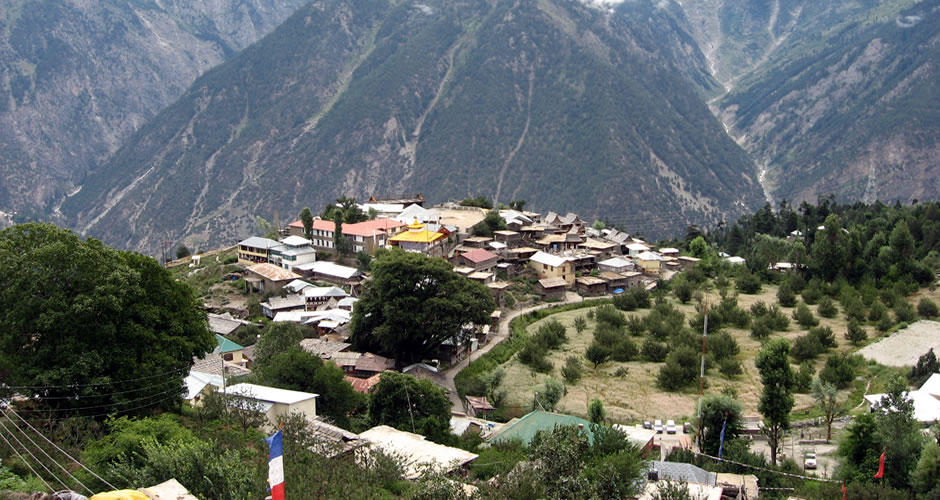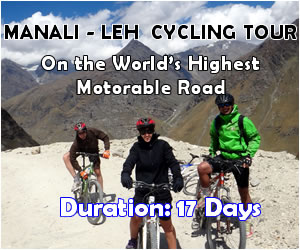Trek and Jeep Safari in Spiti & Kinnaur

Spiti is out of a land of fairy tales and fantasies. Stark ranges that seemed to be painted in shades of russets, purple and pink; erodes mountain-sides strewn with boulders; deep gorges fed by streams…all that are a part of its surrealistic landscape. Small villages of box-like houses along the river valleys, which stand amid lush fields and groves of juniper, poplar and willow, provide splashes of green during the brief summer months. For the rest of the year Spiti is blanketed with snow and temperatures remain well under zero. Spiti with a strong Buddhist tradition has nearly 30 monasteries.
As Spiti lies in the rain shadow of rugged mountain ranges, it has very little rain and is therefore perfect to be visited in the monsoon time.
If one has come to Himalaya to hike across high Himalayan habitations, one will choose a trek in Spiti. Most of this remote and spectacular region is still only accessible by feet.
While trekking through this high altitude cold dessert, we will have a blend of Spiti’s rich culture and natural splendors. This trail provides a unique insight into the Spitians way of life (their homes, cuisine, agriculture and irrigation system). We also might get the opportunity to get a glimpse of some of the world’s rarest species of wildlife, such as snow leopard, Tibetan wolf and blue sheep.
Kinnaur is surrounded by the Tibet to the east,and lies in the northeast corner of Himachal Pradesh. The slopes are covered with thick wood, orchards, fields and picturesque hamlets. The much religious Shivling lies at the peak of Kinnaur Kailash mountain. The district was opened for the outsiders in 1989. The old Hindustan-Tibet Road passes through the Kinnaur valley along the bank of river Sutlej and finally enters Tibet at Shipki La pass.
It is not only the scenic beauty which appeals to the young and old alike, but also the life styles of the people, their culture, heritage, customs and traditions. The people have strong culture and beliefs, generally follow Buddhism and Hinduism, believing the Pandavas came and resided in the land while in the exile. Thousands-year-old monasteries still exist in the area. Buddhists and Hindus live in harmony symbolizing the traditional brotherhood and friendship of the people of both the faiths. Apples, chilgoza (chestnut) and other dry fruits are grown here. The high terrain here facilitates adventures and sports.
Day 1 Arrival in Delhi from abroad
Pick up from airport to hotel, overnight in hotel
Day 2 Sightseeing Delhi, evening drive to Manali by car 585 km
Visit the most famous Sights in Delhi today ( Red Fort, Jama Masjid, Lotus Temple, Qutab Minar…). In the evening we start towards Manali.
Day 3 Manali Rest day and local Sightseeing
Use this day to relax from the overnight journey, visit the market or do some guided local sightseeing with us (The Mall, Tibetan Monastery, Hadimba Temple, Vashisht Hot spring, Manu Temple. Overnight in Hotel
Day 4 Manali to Batel by Jeep 110 km
Today we will start to gain altitude while crossing RohtangPass. After we reach the cold and dry mountain dessert of Spiti and Lahaul Valley, we pass the Bara Shigri Glacier, the biggest glacier in Himachal Pradesh. Our way leads us further to Bathel. Here at the small Dabha we will spend the rest of the day to acclimatize. and start then our trek to the beautiful Chandratal Lake at an altitude of 4270 meters. Chandratal, which means the Lake of Moon, is shaped like a half moon and is set on a large meadow of edelweiss within a lower ridge and the main Kunzum range. From here you have a great view of high mountains and the Baralacha glacier which is the source of theChandra River. Overnight in camp
Day 5 Batel to Chandratal (4270m) trek 4 hours
Today we start our trek to the beautiful Chandratal Lake at an altitude of 4270 meters. Chandratal, which means the Lake of Moon, is shaped like a half moon and is set on a large meadow of edelweiss within a lower ridge and the main Kunzum range. From here you have a great view of high mountains and the Baralacha glacier which is the source of theChandra River. Overnight in camp
Day 6 Chandratal to Kunzum La Trek 3 hours and Kunzum La to Kaza by Jeep 60 km
Today we trek up to the Kunzum Pass, the gateway to the Spiti Valley. From here we continue by jeep. On the route we will enter the first village of Spiti, Lossar, and then we go further to Kaza. Kaza is the head quarter of the Spiti region. Spiti is part of the District of Lahoul & Spiti in Himachal Pradesh. Overnight in hotel
Day 7 Kaza to Kibber(4200m) by jeep 19 km and Kibber to Jete to Ki Trek 4 hours back to Kaza by jeep 13 km
Kibber is considered to be one of the highest permanent settled Village with electricity and road connection in Asia.Ki monastery is the largest gompa in this part of the country. Now over 200 monks reside here. It was built in the 14th century at an altitude of 4160 m. Overnight in hotel
Day 8 Kaza to Langza (4635m) by jeep and Langza to Komik (4600 m) via Hikkim (4500m) trek 4hrs
Langza village is one of the highest villages in Asia. In this area we will find Spiti shells, ammonite, belemnite and fossils from billions of years back. There is a national park for geologist. Also have a look at the golden Buddha. We start trekking from here. The trail slowly winds up to pastures and yaks and sheep are visible during the trek.
We Pass the Village Hikkim until we reach Komik. Here we will stay in the monastery and get served from the monks. Overnight at monastery
Day 9 Komik to Dhimul (4357m) trek 5hrs
On today’s trek we reach our maximum height of this tour: 4900 m. After crossing this little Pass we have a good view down of Dhimul Village.Here you can visit the local Museum, which has a good source of information about not only this place, but also about the unique history of the surrounding villages. Overnight in homestay
Day 10 Dhimul to Lalung (3758m) trek 4hrs
We will see panoramic views of the valley and have an insight in the customs and cultures of the habitants. In Lalung is the oldest temple and probably one of the oldest trees (dating back more than 1000 years) in Spiti. Overnight in homestay
Day 11 Lalung to Dhankar Lake trek to Dhankar(3890m) 5hrs
On this day we have to cross a stream and enter into the valley of monks. There is a small but very enchanting lake. There is an old and famous monastery of the region. Dhankar was the capital of Spiti in oldern days. Overnight in hotel
Day 12 Dhankar to Pin Valley to Tabo (3050m) by Jeep 80 km
Our trek has ended and we enjoy the drive by Jeep, first into the Pin Valley, the land of ibex and snow leopard, further to Tabo.
On the way into the Valley we will visit Spitis 2nd oldest Monastery: The Kungri Gompa.
On the left bank of the River Spiti Tabo is surrounded by high mountains. The thousand year old Tabo Gompa that was established by the legendary Rinchen Tsangpo is considered next in importance only after the Tholing Gompa in Tibet. Overnight in hotel
Day 13 Tabo to Nako 68 km by jeep
Nako, at an altitude of 3662 m in Hingrang Valley is the famous and largest village. Yaks, horses and donkeys are reared here in abundance. Overnight in hotel
Day 14 Nako to Kalpa 123 km jeep
Kalpa, 51 km away from Sangla, is surrounded by vineyards, which are protected from bears by large sheep dogs, especially trained for that purpose. Here you can buy Kinnauri Shawls and caps. Overnight in hotel
Day 15 Kalpa to Recong Peo to Chitkul 77 km by jeep
Recong Peo is the headquarter of Kinnaur district. It is one of the most scenic but less known districts. Here the river Sutley flows through and due to the high altitude the summer are short and the winter long. Due to the proximity to Tibet, the lifestyle and religion has been influenced by Buddhism, through the majority of the people practice Hinduism. Kinnour is a land of Legends and mythology. Today we enter the Sangla Valley, the most romantic and beautiful Valley in Kinnaur District.It is 95 km long and has green pasture land on either side of the River and the meadows close to the river are full of flowers and fruit trees. There are barren ranges of snow all year. Chitkul is the last inhabited Village in that Valley. Surrounded by green fields and high mountain Peaks it is like a fairy tale. Here you can see old quaint little houses, temples and gompas.
On the way to the Sangla Valley you can make a stopover in Sangla. It is situated at an elevation of 2680 m. The Bering Nag Temple and the monastery are worth a visit. There is the famous fair Phulaich, which is celebrated each year in August-September. The wooden houses are a unique example of wooden architecture. One kilometer away is a Saffron farm. Overnight in hotel
Day 16 Chitkul to Saharan 112 km by jeep
Sarahan is a tiny, but beautiful Village in the Sutley Valley surrounded by apple orchards and dominated by the ShrikhandMahadev Peak (5227m). It was the ancient capital of Rampur Bushehr, one of the biggest princely states in the Shimla hills. Here you can visit the Bhimakali Temple with its six silver coated doors. It is a mixture of both, Hindu and Buddhist style and attracts tourist from all over the world. Overnight in hotel
Day 17 Saharan to Shimla 172 km by jeep
In 1864 it was declared as the summer capital of British India. Now Shimla is the capital City of Himachal Pradesh. The famous hill station is a famous spot for foreign and domestic tourist. Overnight in hotel
Day 18 Sightseeing in Shimla
Use this day to relax and do some Sightseeing and Shopping in Shimla. Overnight in hotel
Day 19 Shimla to Kalka by toy train and Kalka to Delhi by car (280 km)
Enjoy the ride by the famous Toy Train from Shimla to Kalpa. It was opened in1903. You will go through 102 tunnels, over 800 bridges and take 900 curves. Enjoy the picturesque landscape. From Kalka it goes to Delhi by car. Overnight in hotel
Day 20 Departure from Delhi back home

